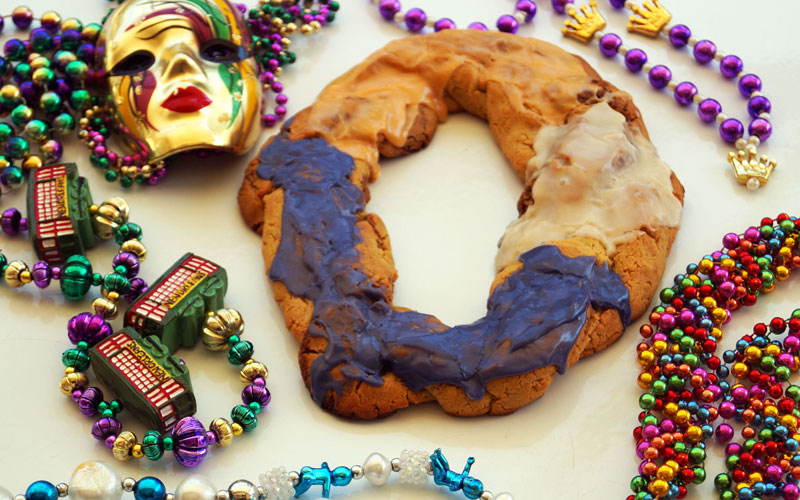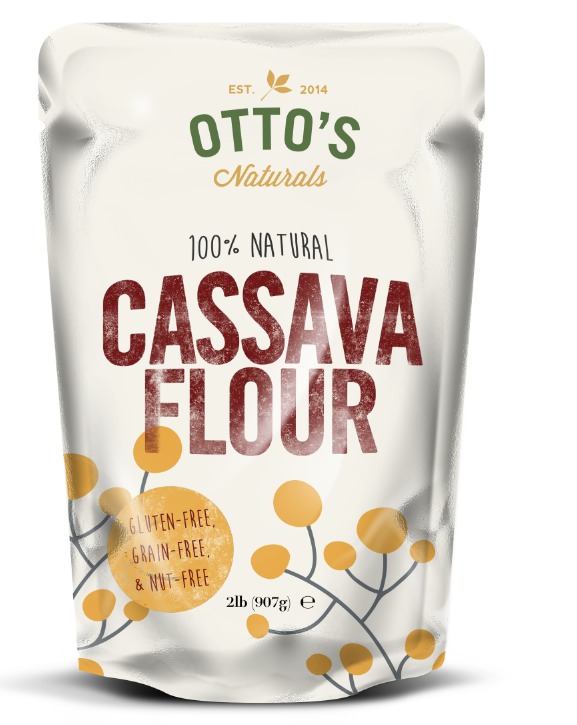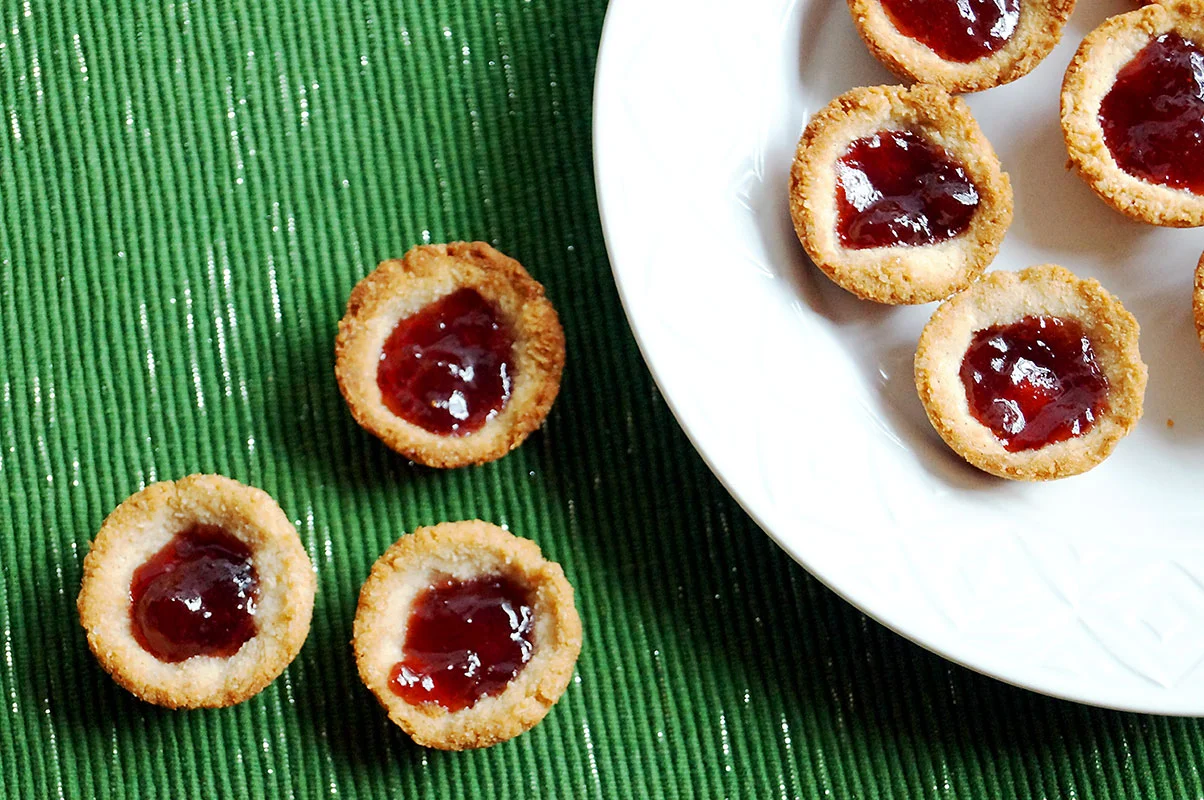Happy Mardi Gras, y'all! I have been craving a king cake all season, and when it turned out I couldn't make it back to New Orleans for Carnival this year, I just had to get in the kitchen to figure out an authentic king cake recipe using paleo ingredients.
Since I am an over-achiever, I made two cakes at the same time using completely different flours as the base. One cake was made entirely with a newcomer in the paleo scene: Otto's Naturals Cassava Flour. Sadie and I had a bit of a long distance bake-off this weekend that was SO much fun. This was my first time experimenting with their new flour, so she was able to give me lots of handy tips. You can see our delicious experiments on Instagram: here is hers and here is mine. Make sure you follow us both!
And let me just say: I am really impressed at how authentic the taste and texture is with the cassava flour. It's not like anything else I've ever worked with that's paleo.
The second cake is a blend of more "common" paleo flours: almond, coconut, tapioca starch, and arrowroot starch. I wanted to test out a recipe using flours you likely already have in your pantry so that you can make a cake before Mardi Gras season is over for the year! Also, what better way to go out with a bang before going on the autoimmune protocol (AIP) for Lent. My whole house is doing it - check out our group on Facebook for more info about that. I'm just doing it for moral support :-)
Bear with me a moment - I want to quickly discuss something important regarding these flours and starches before getting to the recipes.
What's the difference between cassava, tapioca, manioc, and yuca?
Yuca is a tropical root that is a staple starch in many traditional Latin American cuisines. I've got a few recipes on my site that use it. It makes a great starchy nightshade-free and low FODMAP substitute for potatoes.
Yuca is known by many names: cassava, manioc, tapioca. A flour can be made from either the whole dried root or from the extracted starch. In general, the convention for naming goes like this: the starch is labeled tapioca starch or, confusingly, tapioca flour. True flour made from the whole dried and ground root is usually called cassava or manioc flour. There are some exceptions - I have seen "cassava starch" that is truly starch and also "tapioca flour" that is actually the whole root flour and not starch.
Clear as mud, right? I know it's confusing. Check out Otto's FAQ page for more info and tips on how to tell the starch from the flour.
ANYWAY. Back to Mardi Gras. And delicious king cake. But first, a bit about New Orleans.
My New Orleans history
St. Louis Cathedral, French Quarter, New Orleans, LA
Crescent City Water Meter Lid
Amanda aka The Curious Coconut Mardi Gras Day 2007
I lived in New Orleans from 2002 to 2008. Yep, I went through Hurricane Katrina. No, I wasn't there when the storm hit (though I did just barely evacuate - Aug 28th 2005 was my 21st birthday, Katrina hit on the 29th; I had planned to stay put for an epic "hurricane party"...*sad face*...), but I was back about 2 weeks later after having stayed in shelters. We had to sneak past the National Guard to get into the city since it was still on lockdown at that point. Seriously. I was very fiercely loyal to the city even before Katrina, but after going through that ordeal, NOLA will always have a huge part of my heart and will feel like home.
Everyone in the city looks forward to Mardi Gras each year. And if you've got a "Girls Gone Wild" image in your head for what Mardi Gras looks like, it's completely wrong. Yeah, some people do act a fool on Bourbon Street, but that's a teeny tiny fraction of the city and a very poor representation of what Mardi Gras is all about. I've never in 8 Mardi Gras seasons seen anybody flash their boobs for beads (but then again, I avoid Bourbon Street!)
Mardi Gras is a time to let go, relish life, and act like a KID (since you are literally surrounded by them at the parades! Yeah, they are FAMILY events), and on Mardi Gras day you get to dress up however you want. It doesn't have to be like Halloween where you are a character that people can recognize; you get to dress up to express whatever part of you that you want and need to show the world. You can adopt a whole different persona for a day.
Going to New Orleans for Mardi Gras and partying like a local is unlike anything you will ever do anywhere else in the US. You gotta do it at least once in your life. Be sure to do the St. Anne's Parade on Mardi Gras day. Muses, Krewe D'Etat, Bacchus, and Zulu (if you can get up that early LOL) have always been my favorite parades on St. Charles to attend, but there are so many good ones!
What's a King Cake?
King cakes are a traditional part of the Mardi Gras (aka Carnival) season, which begins every year on Twelfth Night (January 6th - 12 days after Christmas) and lasts until Mardi Gras day, which is always the day before Ash Wednesday, when Lent begins. Lent is 40 days before Easter, so all of those days (except 12th night) change every year.
It's traditional to eat your first King Cake on Twelfth Night and your last on Mardi Gras day, with some in between, too. They are meant to be enjoyed at a party with others, and each cake holds a secret surprise inside. These days, you'll find a tiny plastic baby hidden inside (which is supposed to represent baby Jesus), and whoever gets the slice of cake with the baby gets good luck and is dubbed the "king" or "queen" of the party. It also means you have to make or buy the next cake for the next party of the season. Read more about that here.
This is what the tiny plastic babies look like. I was lucky enough to snag a string of beads at a parade one year that had them all over it.
If you are fresh out of little plastic babies, you can also use a dried bean instead. That's what I had to do here! But, again, if I had planned ahead better, I could've ordered some online!
The king cake dough is NOT supposed to be very sweet at all, and instead is more bread like, almost like a French bread or brioche. The filling inside has some sweetness, but not TOO much. The sweetness comes from the glaze on top and the filling inside. Most traditionally, it's a white glaze with colored sugar sprinkles on top. Well, unfortunately the food coloring used on those sugar sprinkles is something I have to avoid these days, so I opted for vegetable-based food coloring to dye the glaze directly. If I had planned ahead better, I could've ordered naturally-dyed sugar sprinkles. This is the brand of coloring I used, but you can also buy this one on Amazon.
The colors on the top of the cake are supposed to be purple (justice), green (faith), and gold (power) - the colors of Mardi Gras. Well, my local natural grocer was fresh out of everything except for blue and orange dye. Yeah, I live in Gainesville where orange and blue are the theme colors thanks to the University of Florida. I was able to make the blue look kinda purple, but that orange just looks like nacho cheese LOL (sorry). But, the same brand I used DOES make the right colors, so you can make your king cake more authentic than mine :-)
Like I said above, I am an over-achiever and made two different cakes for you. I'm being generous and sharing both versions here with you!
A couple of important notes (PLEASE READ!):
- For the almond flour cake: due to the specific blend of flours, the batter does not form a normal dough that you can work and braid. It will more closely resemble a cake or brownie batter than a bread dough. Use a bundt pan to make it hold its shape. Or, if you don't have a bundt pan (like me), use a regular cake pan and put something that's safe to bake in the center, like a ramekin.
- Be sure you are using flour made from whole, dried yuca/cassava. If you buy Otto's brand, you know what you'll be getting. Tapioca starch will not work!!!
- Please read the recipe CAREFULLY and don't be intimidated by its length. It's so long because I'm giving you a couple of choices here - 2 different brioche recipes AND 2 different fillings. You could make 4 different cakes! The brioche can either be cassava flour or an almond blend, and the filling can be a Lemon Cream Cheese (dairy-free) or a Simple Cinnamon. Choose ONE bread and ONE filling and go to town! :-)
- The almond blend is really good, but the cassava is the most authentic thing I have tasted that wasn't made with gluten in a New Orleans bakery. Seriously, you NEED to get your hands on some cassava flour and make it a staple flour in your paleo pantry. It's definitely going to be my go-to flour while I'm on the AIP for Lent!
Paleo Mardi Gras King Cake - Cassava Flour Version
This recipe for paleo king cake can be made with your choice of two different types of dough: 100% cassava flour, or a blend of almond and coconut flours with tapioca and arrowroot starches. Both are DELICIOUS with an authentic taste and texture. You can use the lemon cream cheese filling OR a simpler cinnamon-only if you prefer. Enjoy and laissez les bon temps rouler!
Brioche dough adapted from Betty Crocker's recipe here. Cashew cream cheese filling adapted from the frosting recipe in the cookbook Cooking With Coconut Oil (read my review of that amazing cookbook here.
Prep time: 30 min
Cook time: 30 to 40 minutes
Total time: 60-70 minutes, plus 1 hour for chilling and 1 hour for rising = about 3 hours
OPTION 1 for brioche bread: CASSAVA FLOUR
- 1 cup + 2 Tbsp cassava flour (NOT tapioca starch)
- 1 tsp quick rise yeast (about 1/2 of a quarter ounce pack) NOTE: do not use "active dry yeast"
- 1/2 cup coconut milk
- 2 Tbsp unrefined sugar (I use sucanat, not coconut sugar)
- 1/2 tsp unrefined salt (fine grind)
- 1 large egg (at room temp)
- 3 Tbsp butter or ghee, softened, and cut into 6-8 pieces
OPTION 2 for brioche bread: ALMOND FLOUR BLEND - use the exact same recipe as listed above for cassava flour brioche, but replace the cassava flour with the following blend of flours:
- 1.5 cups almond meal/flour
- 3 Tbsp coconut flour (sifted before measuring - do not skip this step!)
- 6 Tbsp arrowroot starch
- 6 Tbsp tapioca starch
OPTION 1 for the filling: Lemon Cream Cheese (dairy-free)
- 1 recipe cashew cream cheese (see below - about 1/2 cup)
- 2 to 4 Tbsp chopped pecans
- 2 Tbsp sucanat
- 1.5 tsp molasses
- pinch unrefined salt (fine grind)
- zest of about 1/4 lemon (or more for a more lemony flavor)
Dairy-free cashew cream cheese
- 1/2 cup raw cashews
- 1 cup cool water
- 2 Tbsp coconut oil
- 1 Tbsp coconut butter (aka coconut manna, coconut cream concentrate)
- 2 tsp apple cider vinegar (may use more to taste)
- juice of 1/4 lemon (may use more to taste)
- 1/2 Tbsp palm shortening
- 1/2 Tbsp sucanat
- 1 tsp vanilla extract
OPTION 2 for the filling: Simple Cinnamon
- 1/2 cup sucanat
- 3/4 tsp ground cinnamon
- 2 Tbsp butter or ghee, softened
- 1 Tbsp molasses
For the icing (see directions for more info on amounts)
- grain-free powdered sugar
- coconut milk (more as needed to thin the glaze)
- vanilla extract
- vegetable-based food coloring - purple, green, and yellow are traditional
Cooking Directions
- If you will be making the cashew cream cheese, the first thing you need to do is let the cashews soak in cool water. Ideally they will soak for 2 hours, but just let them soak as long as you can. If you want, you can soak them the day before you are making the cake. When you are ready to start making the cake, take the butter and egg out of the fridge to let them come to room temp. Also choose whether you want to make the CASSAVA bread or the ALMOND BLEND bread. Differences in directions will be noted in bold; otherwise they are the same process.
- In a small saucepan, heat coconut milk, sugar, and salt together until the temperature reaches 120-130F. Use a candy thermometer to check - do NOT guess or you could ruin the yeast.
- While milk is heating, add flour and yeast to a large mixing bowl and stir with a spoon to combine.
- Pour warm milk mixture into bowl with flour and stir to combine. Add the egg and continue stirring until a unifrom batter forms. Add softened butter and use a dough blender to incorporate. You may also use a fork. NOTE: if you are using the cassava flour, knead the dough for a minute. It should not be sticky and you should be able to form a ball with it easily. If dough is too wet, add extra flour 1/2 Tbsp at a time until it resembles a "real" bread dough. If it is too dry, work in coconut milk about 1 tsp at a time. For the almond flour blend, you will be working with something that looks more like a cake or brownie batter than a bread dough, which is how it is supposed to be, dont' worry.
- If using cassava flour dough, roll into a ball and coat with a small amount of fat (like cocout oil or palm shortening) and return to bowl. Cover bowl tightly with plastic wrap and chill in refrigerator for 1 hour. If using almond flour blend, just cover the bowl tightly with plastic wrap and chill in the fridge for 1 hour. You won't be able to form it into a ball that stays.
- While waiting on dough to chill, make the filling. Choose EITHER the Lemon Cream Cheese OR the Simple Cinnamon. If making the Lemon Cream Cheese, first make the cashew cream cheese. Drain cashews after they have soaked for ideally at least 2 hours and up to 24. Puree into a smooth butter using a food processor or blender. Add coconut oil, coconut butter, apple cider vinegar, lemon juice, palm shortening, sucanat, and vanilla extract and blend to combine into a uniform, smooth spread. Taste it to see if it needs extra lemon juice or ACV.
- Combine your cashew cream cheese with chopped pecans, sucanat, molasses, salt, and lemon zest in a bowl, stirring with a spoon or spatula to combine. Store in refrigerator until ready to use (it's easier to work with chilled in my opinion).
- To make the Simple Cinnamon filling, just mix together the sucanat, cinnamon, butter or ghee, and molasses in a bowl with a fork. Leave at room temperature until ready to use.
- Remove chilled dough from the fridge and roll out into a rectangle about 10 inches long by 5 inches tall. Take filling of choice and spread evenly across one half of the dough length-wise. Cassava flour: fold the side of the dough without filling over top of the side with filling and press the edges to seal the filling inside. Then, take a knife and cut 4-6 thin strips lengthwise. Carefully create 2 braids using 2 or 3 strips in each braid, then connect the two braids in an oval shape by pinching the ends together. Almong flour blend: You should be able to roll out the dough into the same shape as the cassava. Go ahead and cut the rolled dough in half lengthwise. Lift half and layer it in the bottom of your cake or bundt pan (leave space in the center for a hole if using plain cake pan) - you'll have to work with it a bit to get the shape right. Then, layer the filling on it in the pan, then seal it with the remaining half of the rolled out dough. Press the edges together to seal the filling inside. Place a ramekin (or similar oven-safe circular object) in the center of the cake pan if not using a bundt pan.
- Cover prepared cakes with plastic wrap and let sit for 1 hour to let the dough rise.
- When dough is nearly finished rising, pre-heat oven to 350F. Bake cakes for 30 to 40 minutes, or until the tops are golden brown. I baked the cassava for about 35 minutes and the almond about 43 actually. Let cake rest about 5 minutes before icing. Now is also the time to hide your tiny plastic baby or dried bean in the cake - best to do it from the underside by cutting a small slit with a knife and inserting.
- To make icing, add approximately 1/4 cup sifted powdered sugar, 1-2 tsp coconut milk, and a splash of vanilla (less than 1/4 tsp) to a bowl and stir. Add extra milk if too thick or extra sugar if too thin. Then, add food coloring one drop at a time, stirring well with each drop, until desired color is achieved. Repeat in new bowls for additional colors. Drizzle icing liberally on top of cake in desired pattern.
- Slice and enjoy with good company! Happy Mardi Gras! King cake also makes a great breakfast treat with coffee or tea - yum! Oh, and do be careful if you choose to insert a baby or bean in your cake - let everyone know to watch for it and to eat mindfully! :)
Want to share? Pin it here!
Recommended Ingredients
These are the ingredients that I use in my own kitchen at home, which are available from my affiliate partners. I only recommend things I love to use myself and that I think you will love, too! Click on any image to learn more about the product.




























